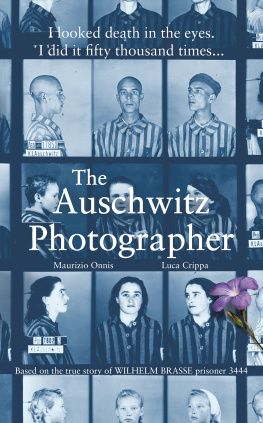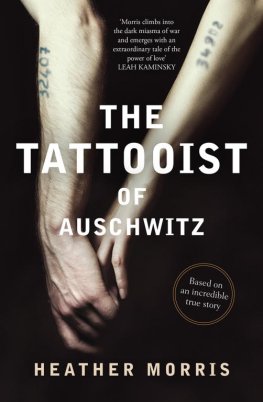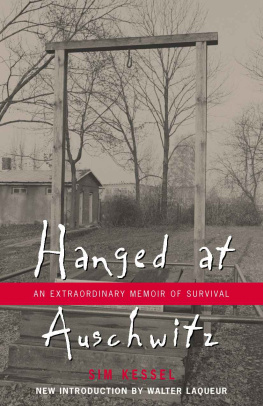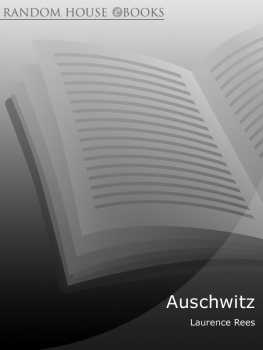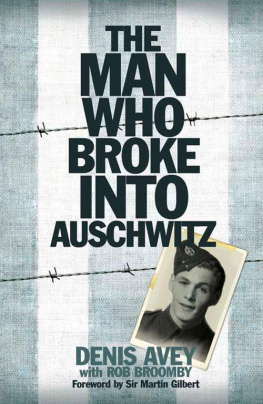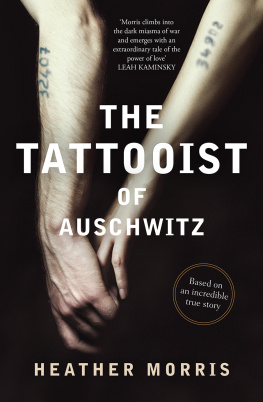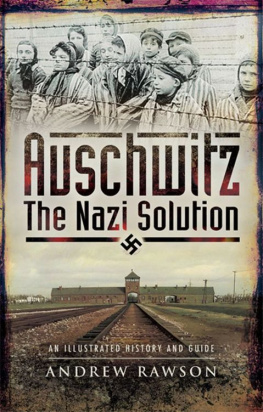Copyright 2013 by Edizioni Piemme S.p.a., 2018 by Mondadori Libri S.p.a. English translation Jennifer Higgins
Cover and internal design 2021 by Sourcebooks
Cover design by James Iacobelli
Cover images Jack Halford (EyeEm)/Getty Images
Internal design by Danielle McNaughton/Sourcebooks
Sourcebooks and the colophon are registered trademarks of Sourcebooks.
All rights reserved. No part of this book may be reproduced in any form or by any electronic or mechanical means including information storage and retrieval systemsexcept in the case of brief quotations embodied in critical articles or reviewswithout permission in writing from its publisher, Sourcebooks.
Originally published as Il fotografo di Auschwitz, Edizioni Piemme S.p.a., 2013. Translated from Italian by Jennifer Higgins.
This publication is designed to provide accurate and authoritative information in regard to the subject matter covered. It is sold with the understanding that the publisher is not engaged in rendering legal, accounting, or other professional service. If legal advice or other expert assistance is required, the services of a competent professional person should be sought. From a Declaration of Principles Jointly Adopted by a Committee of the American Bar Association and a Committee of Publishers and Associations
Published by Sourcebooks
P.O. Box 4410, Naperville, Illinois 60567-4410
(630) 961-3900
sourcebooks.com
Originally published as Il fotografo di Auschwitz in 2013 in Italy by Edizioni Piemme S.p.a., an imprint of Mondadori Libri. This edition issued based on the hardcover The Auschwitz Photographer: Based on the True Story of Wilhelm Brasse Prisoner 4333 in 2021 in Great Britain by Doubleday, an imprint of Transworld Publishers.
Library of Congress Cataloging-in-Publication Data is on file with the publisher.
A Hedy Epstein, lei sa perch.
Alle migliaia di giovani che in questi anni ci hanno ascoltato raccontare questa storia.
To Hedy Epstein, she knows why.
To the thousands of young people who, over the last few years, have heard us tell this story.
Contents
For the sake of narrative and in service to the translation from the original Italian, some changes have been made to the timeline of events.
PROLOGUE
Auschwitz: An Afternoon at the Identification Service
Wilhelm Brasse switched on the enlarger, and a bright beam of white light fell onto the sheet of photographic paper. The negative had been developed that morning by Franek Myszkowski, one of his colleagues, and Brasse hadnt even glanced at it. Myszkowski was a skilled lab technician, so Brasse was sure the negative would have the correct contrast and exposure. Brasse also knew his way around the enlarger, having worked with it for so long, and he was sure that with this medium-density negative, a dozen or so seconds of exposure would be enough to create the print. After exactly twelve seconds, he switched off the white light, and the room returned to semidarkness, illuminated only by the red safety lamp.
His boss, SS Oberscharfhrer Bernhard Walter, had asked him to produce large prints, so Brasse had placed a thirty-by-forty-centimeter sheet of photographic paper on the base of the enlarger. Now he took the sheetwhich already contained the secret of the image projected from the negative but was still invisible, still immaterialand immersed it in the developing tank. He waited impatiently, as he always did at this stage of the operation, and the image slowly began to take form. It was a face; there could be no doubt about it.
First to emerge were the outlines of the eyes and a few darker strands of hair, then the features and the neck. A woman with a dark complexion. She was young and wore a scarf tied around her head.
When the pupils had become fully black, Brasse took the sheet out of the developer, rinsed it quickly, and submerged it in the tank of fixer: half a minute would be enough. He didnt even look at the timer sitting on the shelf next to him. This process had become second nature to him, and for a while now, he had no longer needed instruments to measure it. Finally, he extracted the sheet from the fixer, washed it carefully once more so the print wouldnt turn yellow, and hung it on a line to dry. He had asked Walter for a print dryer, but his superior was having trouble getting new equipment sent from Berlin. As for looking for one in Warsaw, there was no point: the Germans had already taken anything that could possibly be useful. Only after hed hung up the print did Brasse switch the darkroom light back on. Standing there, in front of the line, he studied the image. He felt a surge of satisfaction: the print was perfectly developed and the contrast was just right. But that feeling quickly gave way to one of unease. The womans eyes fixed him with a terrible gaze.
Disturbed, he took a step back to take a better look.
He wouldnt have been able to say from what distant country she came: the portrait was too close up for him to deduce anything from her clothes or other details. It was a face similar to the thousands of others he himself had immortalized here in the Erkennungsdienstthe camps Identification Service. The woman could be French or Slovak, a Jew of any nationalityRomani even, although her features werent like those of the nomads seen in Auschwitz. She could be German, punished for something the Nazis didnt like.
He didnt know.
The photograph had been taken by Walter, who didnt waste time explaining things. Brasse himself never went outside to take photographs. He had the authorization to do so but didnt want to. Unless they ordered him to do otherwise, he preferred to stay here, shut away in the warm studio, working alongside the other men in his kommando, as the SS called the various teams assigned to different tasks in the camp. Walter, on the other hand, liked taking photographs and producing short films out in the sunlight. He would then take everything back to the studio to be developed and printed.
The Oberscharfhrer appreciated and respected his chief portraitist, but he never failed to remind Brasse that he himself was an SS man and Brasse was a prisoner, worth less than zero. Brasses abilities were too useful to him, though, and with time, he had even developed a fondness for this Polish deportee. They chatted with each other, and Walter would ask Brasses opinion on technical problems and entrust him with the most difficult jobs.
That morning, Walter had come into the studio earlybefore the queue of prisoners to identify and register had even formedand when he appeared, everyone sprang to attention. The German had a roll of film in his hand, and judging by the care with which he was carrying it, it must have been something precious, and there was a lot of itseveral meters.
Wheres Brasse?
In the darkroom, answered Tadek Brodka, who was preparing the equipment for the mornings work.
Walter crossed the room quickly and knocked on the door to the laboratory. He didnt want to barge in while the red light was on; he would have ruined his favorite prisoners work. Only when he received permission to enter did he open the door.
Good morning, Herr Brasse. How are you today?
The photographer smiled at him. As well as ever, Herr Oberscharfhrer. How can I help you?
Walter held up the roll of film, then put it down on a table. Heres some more work for you. When do you think you can develop it and get it printed?


